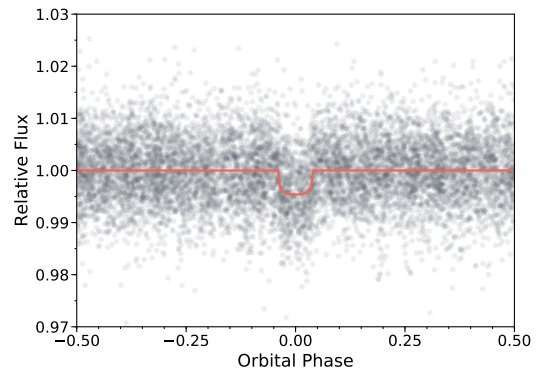December 3, 2018 report
Astronomers detect low-mass brown dwarf around A-type main-sequence star

Using HATSouth Exoplanet Survey, an international group of astronomers has discovered a low-mass brown dwarf transiting an A-type main-sequence star. The newly detected brown dwarf, designated HATS-70b, is the first such object found around a star of this type. The finding is detailed in a paper published November 16 on arXiv.org.
Brown dwarfs are intermediate objects between planets and stars. Astronomers generally agree that they are substellar objects occupying the mass range between 13 and 80 Jupiter masses. Although many brown dwarves have been detected to date, such objects existing as companions of other stars are a rare find.
Now, a team of researchers led by George Zhou of Harvard-Smithsonian Center for Astrophysics (CfA) in Cambridge, Massachusetts, reports the finding of a new example of a rare brown dwarf companion orbiting an A-type main-sequence (or A dwarf) star known as HATS-70. The astronomers employed the Hungarian-made Automated Telescope Network-South (HATSouth) to observe HATS-70 and found that this star is transited by some object.
Next, the team conducted follow-up photometric and spectroscopic observations of HATS-70 in order to uncover basic parameters of the companion and its host.
"We report the discovery of HATS-70b, a transiting brown dwarf at the deuterium burning limit. (…) The transits were first identified by the HATSouth network (Bakos et al. 2013), and confirmed via photometric and spectroscopic follow-up observations that measured the radius and mass of the companion," the researchers wrote in the paper.
According to the study, HATS-70b is about 38 percent larger than Jupiter, has a mass of some 12.9 Jupiter masses and an equilibrium temperature of 2,370 K. The brown dwarf resides in a close-in orbit, separated from the host by only 0.036 AU, with an orbital period of 1.89 days.
With an age of about 810 million years, the parent star is nearly two times larger than the sun and has a mass of around 1.78 solar masses. The host has an effective temperature of 7,930 K and a luminosity of approximately 12 solar luminosities. The HATS-70 system is located around 4,260 light years away from the sun.
The researchers emphasized that HATS-70b is the first detected brown dwarf companion transiting an A dwarf star. Furthermore, HATS-70b is one of few massive planet or brown dwarf systems with a measured obliquity. The study found that this object, like previously studied massive planets and brown dwarfs, orbits in a low projected-obliquity orbit with 8.9 degrees. Such a low obliquity, when it comes to massive objects, still baffles astronomers.
"The low obliquities of these systems is surprising given all brown dwarf and massive planets with obliquities measured orbit stars hotter than the Kraft break. This trend is tentatively inconsistent with dynamically chaotic migration for systems with massive companions, though the stronger tidal influence of these companions makes it difficult to draw conclusions on the primordial obliquity distribution of this population," the authors of the paper wrote.
They added that finding more high-mass companions with obliquities measured, around hot stars could be crucial for determining the origins of close-in orbit brown dwarfs like HATS-70b.
More information: G. Zhou et al. HATS-70b: A 13 Mjup brown dwarf transiting an A star. arXiv:1811.06925 [astro-ph.EP]. arxiv.org/abs/1811.06925
© 2018 Science X Network



















